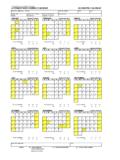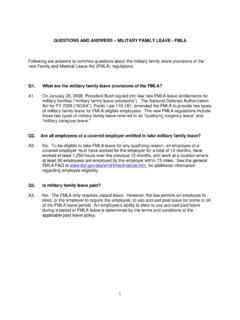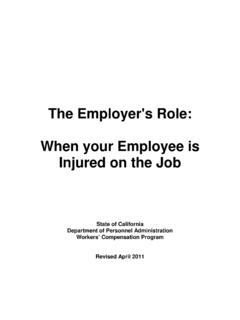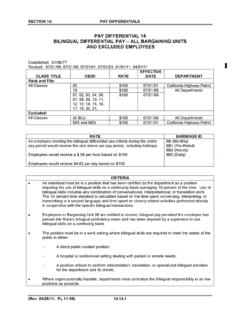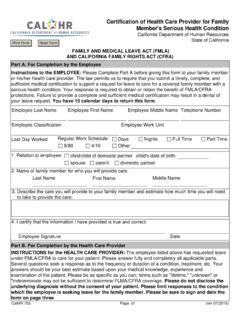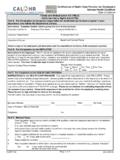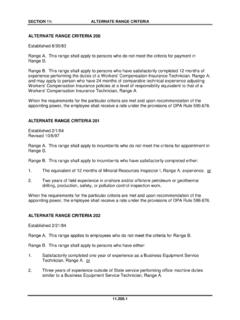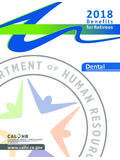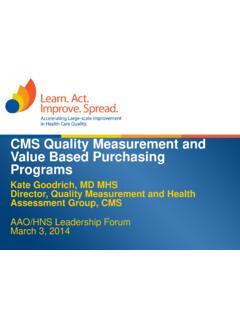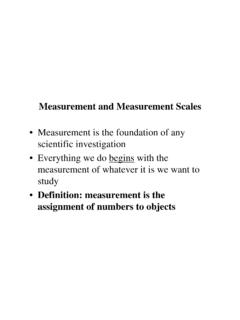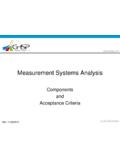Transcription of Measuring (and Driving) the Value of Training - CalHR Home
1 Measuring ( and driving ) the Value of Training CNLP Quarterly Meeting / December 16 2014 Bruce Winner Los Rios CCD Government Training Academy Email - Web Site - Bruce blogs to the Training Community at: 1 12/14/20141*Find out the difference between a simple evaluation and truly Measuring the Value of Training at the five generally accepted levels. * Discover what measures are most important to management, and how to capture that information. *Stop guessing about the appropriate level of measurement and see what the experts and empirical evidence reveals is optimal. *Explore with your colleagues how to create the systems and practices necessary (before, during, and after Training ), to ensure that your hard efforts result in real Value , measured at an appropriate or Kirkpatrick Levels of MeasurementLevelMeasurement Focus0.
2 InputMeasures input such $ spent, people trained, $ per trainee1. Reaction and RelevanceMeasures participant reaction to the program, did they find it relevant, and could capture planned action(s)2. LearningMeasures changes in knowledge, skills, and attitudes3. Application & ImplementationMeasures what is applied on the job, changes in job behaviors (more of x, less of y) 4. Business Impact (Results)Captures changes in business impact measures ( )5. ROIC ompares program benefits to program costs (simple ration or benefits minus cost / cost)12/14/20142 Levels of Measurement Examples4 Level 0 Input and Indicators Number of projects Audiences Web site hits Request Attendance Costs Time to DeliverLevel 1 Reaction and Planned Action Relevance Importance Usefulness Appeal Emotion Brevity Uniqueness Concreteness New Information Motivation Appropriateness Intent to UseLevels of Measurement Examples5 Level 2 Learning and Confidence Information Knowledge Understanding Capability Contacts Confidence Perceptions SkillsLevel 3 Application and Implementation Use of Information Use of Knowledge Use of Skill Completion of Actions Completion of Tasks
3 Implementation of Ideas Following the Policy Use of Procedure Use of Regulation Success with Application Barriers EnablersLevels of Measurement Examples6 Level 4 Business Impact Productivity Quality Cost Output Incidents Time (saved) Efficiency Compliance Discrepancies Employee RetentionLevel 5 Return on Investment ROI (%) Benefit Cost Ratio Payback Period12/14/20142 ROII mpactApplicationLearningReaction & Planned Action3 Level 5: 5 10%Level 1: 90 100%Level 2: 40 60%Level 3: 30%Level 4: 10 20%Evaluation TargetsThe Executive View of Metrics / RESULTSM easureWe Currently Measure ThisWe Should Measure this in the FutureMy ranking of the importance of this measure1. Inputs: Last year, 78,000 employees received formal learning.
4 94%2. Efficiency: Formal learning costs $ per hour of learning consumed. 78%3. Reaction: Employees rated our Training very high, averaging out of 5. 53%4. Learning: 92% of participants increased knowledge and skills 32%5. Application: At least 78% of employees are using the skills on the job 11%6. Impact: Our programs are driving our top 5 business measures in the organization. 8%7. ROI: Five ROI studies were conducted on major programs yielding an average of 68% ROI. 4%8. Awards: Our learning and development program won an award from American Society for Training and Development 40%Fundamentals for Professional Trainers Name (optional) _____ Reaction/Relevance course provided knowledge, skills, tools or techniques relevant to my instructor/trainer effectively used lecture, exercises and discussion toincrease my understanding of course participant guide, handout materials, and job aids used in the course aidedmy understanding of the subject related to course relevance, trainer or materials: _____ _____ Learning My level of knowledge regarding Training Fundamentals.
5 PRIOR to the series the series completion Impact Please check any of the following impact measures that you feel will result from the application of knowledge or skills from this course: Improved Quality (with any aspect ofADDIE) Increased Trainee or ManagementSatisfaction Increased Efficiency (with any aspect ofADDIE) Improved Productivity (with any aspectof ADDIE) My Course Suggestions Suggested course additions, deletions or modifications: Keep This! I found this useful and relevant _____ _____ Drop This! I found this neither useful nor relevant _____ _____Other Comments Regarding This Course: _____ _____ Application will be able to apply the knowledge and skills learned in this course when I return to my estimate I will use the tools or techniques learned in this course to the following extent (circle one):Please identify any barriers that you anticipate may hinder your ability to apply new knowledge or skills gained from this course: _____ _____ 5 4 3 2 1 Strongly Agree Strongly DisagreeNone Limited Moderate Significant Very Significant Thank You!
6 !5 4 3 2 1 Strongly Agree Strongly Disagree5 4 3 2 1 Strongly Agree Strongly Disagree5 4 3 2 1 Strongly Agree Strongly Disagree5 4 3 2 1 Extensive Knowledge Very Little Knowledge5 4 3 2 1 Extensive Knowledge Very Little KnowledgeExercise: Matching Evaluation Levels with Objectives Instructions: For each objective listed below, indicate the level of evaluation at which the objective is aimed. This is more fun as a table-top exercise. Work as a group and try to match an evaluation level to EACH objective in as short a time as 1. Reaction and Planned Action 4. Business Impact 2. Learning 5. Return on Investment 3. Application Objective Evaluation Level After completing this program or project, participants should: 1.
7 Improve work group productivity by 20% 2. Initiate at least three cost reduction projects in 15 days. 3. Achieve an average cost reduction of $20,000 per project. 4. Use counseling discussion skills in 90% of situations where work habits are unacceptable. 5. Achieve a 2:1 benefit to cost ratio one year after the new performance-management system is implemented. 6. Be able to describe the four elements of the employee assistance program. 7. Increase the customer satisfaction index by 25% in 3 months. 8. Integrate patient records into new database following the 5-step process. 9. Increase research grant funds by 20%. 10. Achieve a leadership simulation score average of 75 out of a possible 100. 11. Conduct a performance review meeting with direct reports in three weeks to establish performance improvement goals.
8 12. Provide a 4 out of 5 rating on appropriateness of new ethics policy. 13. Decrease the time to recruit new professional staff from 35 days to 20 days. 14. Complete all action items on the action plan in 60 days. 15. Perceive the flextime work schedule system as important to their success. 16. Enroll in the career enhancement program with a goal of a participation rate of 15%. 17. Decrease the number of security breaches of patient records. 18. Achieve a post-test score increase of 30% over pre-test. 19. Use the new software as reflected by an 80% score on an unscheduled audit in 3 weeks. 20. Submit suggestions for improvement in the first year (with a10% target). 6 12/14/20143 ParticipantTrainerSupervisor / ManagerBEFORE TrainingRemember our earlier example from today?
9 Trainer creates objectives at four or five even though they may NOTbe measuredDURING TrainingRemember our earlier example from today? .. Participants submit new feedback via a Redesigned Level ONE EvaluationAFTER TrainingA Supervisor Example ..Example The supervisor works with the Training participant weekly for 8 weeks after the Training to make sure application takes Transfer of Training Examples for an Upcoming ExerciseThe Transfer of Training MATRIXT ransfer of Training Exercise Directions1) Do the exercise as a table group 2) Each Table has a number (1 9) that corresponds to one of nine squares on the T of T Matrix (see below)THEN Use the oversized Post IT Notes to: 3) Each table creates at least one intervention or means to increase transfer of Training at a specific point in time (before, during, or after) with one specific group (participants, trainers, or supervisors) Your number 1 9 is your box 4) Then produce 1 or 2 additional interventions for ANY BOX in the matrix5) Post ONLY two to the wall chart (one required and one extra)ParticipantTrainerSupervisor / ManagerBEFORE Training123 DURING Training456 AFTER Training789 Resources for Measuring ( and driving ) the Value of Training ASTD Handbook for Workplace Learning Professionals 2nd Edition, Elaine Biech, ASTD Press, 2014.
10 You ll find this compilation of works from over 90 experts and well known Training professionals at This 2nd edition handbook should be on the shelf of every Training department. Note: See Section V for a concise contemporary overview of Measuring and transferring learning, including chapters on the Kirkpatrick and ROI methodologies. ======================= ROI (Return on Investment) Methodology / Go to - Beyond Learning Objectives: Develop Measurable Objectives that Link to the Bottom Line, Jack J. Phillips, ASTD Press, 2008. The Value of Learning: How Organizations Capture Value and ROI and Translate It into Support, Improvement, and Funds, Patricia P Phillips and Jack J. Phillips, Pfeiffer, 2007 Measuring for Success: What CEOs Really Think about Learning Investments, Jack J.

